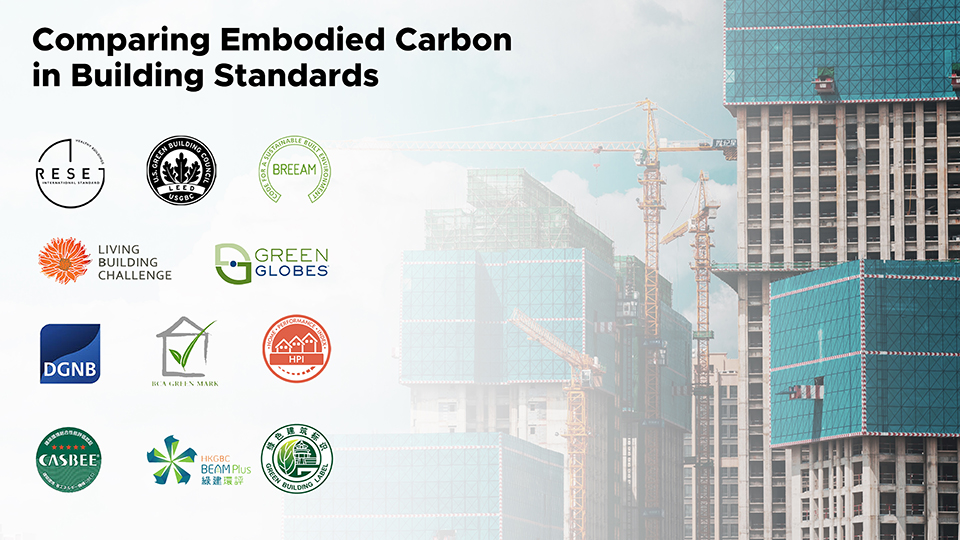Comparing Embodied Carbon in Building Standards from Around the World

After publishing "Comparing Building Standards from Around the World 2.0", we received requests to delve into subsections of the criteria requirements. One of the subsections requested was embodied carbon. For this report, the focus will be on embodied carbon.
What is Embodied Carbon
In real estate, embodied carbon refers to the CO₂ emissions associated with the construction process of a building or space, which includes all of the CO₂ generated during the raw material production, material transportation to the project site, and on-site construction.
Many green building standards include embodied carbon as part of their requirements or scoring. The table below provides an overview of whether a building standard includes embodied carbon in its audit:

Table 1: Overview of embodied carbon information for each building standard. (Note: To see the table more clearly, Right Click > View Image or zoom in on mobile.)
Out of the 19 building standards from "Comparing Building Standards from Around the World v2", 11 have references to embodied carbon. For this report, we compare the embodied carbon requirements of each of these 11 standards from four perspectives:
Required/Optional
Target Thresholds
Actual Material Data
Total Embodied Carbon Data Disclosure
Details are presented in the table below, which includes all the green building standards that include Embodied Carbon somewhere in their requirements:

Table 2: Overview of embodied carbon information from 4 perspectives for each building standard. (Note: To see the table more clearly, Right Click > View Image or zoom in on mobile.)
1. Required / Optional
For the criteria, we examine whether each building standard mandates the assessment of embodied carbon with the following options:
Required: The embodied carbon part of the audit is a mandatory requirement or prerequisite to obtaining the standard’s certification.
Optional: The embodied carbon part of the audit can earn points to obtain the standard’s certification. The certification can still be achieved even if an embodied carbon audit is not conducted.
Details are provided in the table below:

Table 3: Overview of required & optional information for each building standard. (Note: To see the table more clearly, Right Click > View Image or zoom in on mobile.)
To achieve certification for RESET Embodied and LBC Energy Petal, both of which are modular components of their respective building standards, auditing embodied carbon is a mandatory requirement. SG Green Mark and Home Performance Index require an embodied carbon audit as one of the prerequisites.
For other standards, an embodied carbon audit contributes to additional points but is not a mandatory requirement for certification achievement.
2. Target Thresholds
Target thresholds refer to whether the standard requires a baseline threshold to score or award points for the project’s embodied carbon performance.
Details are provided in the table below:

Table 4: Overview of target thresholds information for each building standard. (Note: To see the table more clearly, Right Click > View Image or zoom in on mobile.)
RESET: No
RESET does not require an explicit target to be achieved. The data is representative of the project’s embodied carbon performance and is used for benchmarking internally and against industry averages;LEED: Yes & Optional
LEED requires projects to demonstrate reductions compared with the project baseline of at least 20% of global warming potential and demonstrate at least 10% reduction in two additional impact categories. The baseline and proposed project must be of comparable size and function, service life, and building type; (refer to the LEED v4.1 BD+C & ID+C for more details)BREEAM: No
The objective for BREEAM is to gather carbon data in order to create benchmarks. BREEAM does not currently provide explicit guidelines for the projects' embodied carbon performance or specific details on emission reduction targets;LBC: Yes & Required
Projects must demonstrate a 20% reduction in the embodied carbon of primary materials compared to an equivalent baseline. All projects (except Landscape + Infrastructure) must select interior materials with lower than industry average carbon footprint for product categories for which embodied carbon data is readily available; (refer to the v4.0 Energy Petal Handbook for more information about establishing baselines)Green Globes: Yes & Optional
The final building design shall achieve a minimum 5% reduction for GWP and at least two other impact indicators, with no impact indicator exceeding the baseline building by more than 5%; (refer to the "Whole Building Life Cycle Assessment: Reference Building Structure and Strategies" published by the ASCE SEI Sustainability Committee for more information about establishing baselines)DGNB: Yes & Optional
A complete building life cycle assessment, calculated per predefined conventions, is evaluated against a benchmark; (refer to https://se2050.org/dgnb-german-sustainable-building-council-2020/#1669146494948-800f8190-048b for more details)SG Green Marks: Yes & Optional
For concrete, glass, and steel:
1 point for 10+% reduction for embodied carbon against reference
2 points for 30+% reduction for embodied carbon against reference
Embodied carbon reference values for various building typologies from SG Green Mark:
Non-Residential: 1000 kgCO2e/m²
Residential: 1500 kgCO2e/m²
Industrial: 2500 kgCO2e/m²
Home Performance Index: Yes & Optional
Projects with embodied carbon reduction when compared to the benchmarks can earn extra points. Benchmarks are shown below:LEVEL 1
1 or 2 storey Homes and Homes > 133sqm: 575 kgCO2e/m²
All other homes: 800 kgCO2e/m²
LEVEL 2
1 or 2 storey Homes and Homes > 133sqm: 450 kgCO2e/m²
All other homes: 625 kgCO2e/m²
CASBEE: No
CASBEE does not establish set carbon reduction goals for projects. However, it provides carbon data for various building types and materials as references for project applications; (refer to the CASBEE Technical Manual 2014 edition for more details)HKGBC BEAM Plus: Yes & Optional
Reduced environmental effects must be demonstrated by conducting a Life Cycle Assessment (LCA) (during the design stage with a service life or 50+ years) on a baseline case and the proposed case; (refer to BEAM PLUS New Buildings V2.0 for more details)China Green Building Standard: No
Carbon reduction targets are not mentioned.
3. Actual Material Data
Actual Material Data refers to embodied carbon footprints that are calculated based on the actual materials used, aiming to represent the most accurate embodied carbon data of a project.
A project that uses actual material data would be calculated by summing all the material data with the quantity measured from the actual construction. Calculations derived by software during the design phase are not considered actual material data, as the simulated results may deviate from the actual material usage.
The table below indicates whether the embodied carbon data audited by each standard requires the use of actual material data:

Table 5: Overview of actual material data information for each building standard. (Note: To see the table more clearly, Right Click > View Image or zoom in on mobile.)
Except for RESET, embodied carbon data audited by all other standards do not require the use of actual material data.
The RESET Embodied Standard mandates that a project's calculated embodied carbon footprint must use the data of actual materials. Additionally, RESET requires a site audit that examines the actual quantity of materials used in a project, cross-referencing them with the material list used in calculations, ensuring the authenticity of the data, resulting in third-party verified embodied carbon metrics that can be used for pursuing embodied carbon neutrality.
In contrast, the other standards only require data to originate from recognized carbon calculation software. Such software typically estimates and simulates calculations for materials during the design phase. As these simulations may significantly deviate from the actual construction materials, they cannot be classified as real material data.
4. Total Embodied Carbon Data Disclosure
Total Embodied Carbon Data Disclosure refers to whether the final total embodied carbon data for a project will be shared with investors and clients, or even made publicly available. For the industry, the more that embodied carbon project data is made accessible, the more that comparative baselines can be established, serving as references and benchmarks to assist the construction industry in better carbon emission management and reduction.
Details are provided in the table below:

Table 6: Overview of total embodied carbon data Disclosure information for each building standard. (Note: To see the table more clearly, Right Click > View Image or zoom in on mobile.)
Out of the 11 standards, only the Home Performance Index explicitly mentions the disclosure of embodied carbon data: "A minimum Level 2 needs to be met for developments larger than 5000m² and results must be disclosed to investors and clients. "
RESET does provide projects with total embodied carbon data that can be shared, but data disclosure is optional. RESET's report and metrics encompass the project's total embodied carbon data outcomes with comparisons to industry averages.
For the remaining standards, a project does not necessarily have a total embodied carbon metric upon certification and there is no explicit statement as to whether embodied carbon data should be disclosed.
Regardless of requirements around data disclosure, one thing all green building standards agree on and advocate for is project transparency and information sharing to better the industry’s carbon management and reduction efforts.
Sources
LEED: "LEED v4.1 BD+C & ID+C." U.S. Green Building Council, 2022.
BREEAM: "BREEAM International New Construction V6.0." BRE Global Ltd, 2021. https://files.bregroup.com/breeam/technicalmanuals/sd/international-new-construction-version-6/?
LBC: "LBC v4.0 Handbook" International Living Future Institute, 2019, pp. 42-43.
Green Globes: "Credits Related to Embodied Carbon in North American Green Rating Systems" Structural Engineering Institute, 2021, pp. 3-5.
DGNB: "EMBODIED CARBON IN GREEN RATING SYSTEMS" Structural Engineering Institute, 2020. https://se2050.org/dgnb-german-sustainable-building-council-2020/#1669146494948-800f8190-048b
SG Green Marks: "Green Mark Cn Technical Guide" Building and Construction Authority, 2021, pp. 11-12.
Home Performance Index: "HPI Technical Manual v3.0" Irish Green Building Council, 2022, pp. 47-49.
CASBEE: "CASBEE for Building (New Construction) Technical Manual" Institute for Building Environment and Energy Conservation, 2014, pp. 233-239.
HKGBC BEAM Plus: "BEAM PLUS New Buildings V2.0" HKGBC, 2023, pp. 235-236.
China Green Building Standard: "绿色建筑评价标准" China CABR, 2018, pp. 33.
This comparative report series is a work in progress and we intend to add it to our Resources page in the near future.
In the mean time, if you have any comments or feedback (i.e. mistakes, content you want us to add, etc.), please do not hesitate to let us know by emailing us at info@reset.build.
Research performed by Yingjun Peng and Ryan Ni.
About RESET®
RESET® is a data standard, accompanied by a set of assessment tools, created and managed by GIGA to develop actionable, long term strategies towards health and sustainability for the built environment. RESET focuses on creating a structure around data and analytics to generate opportunities for improvement and optimizations by combining the development of continuous monitoring and cloud software to increase the visibility of health and sustainability data in the built environment.
For more information about RESET, please visit: https://www.reset.build/
